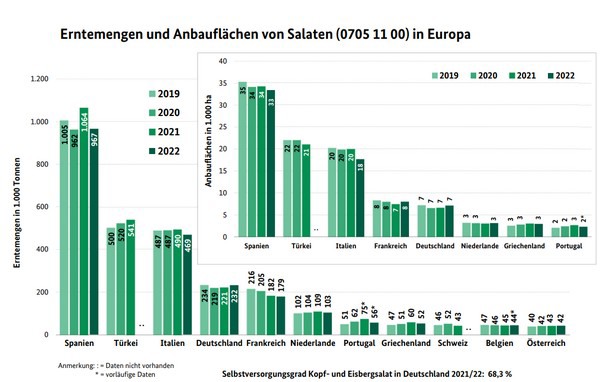In the case of iceberg lettuce, Spanish offers could be accessed almost exclusively, domestic supply flanked them with only very small quantities. According to the BLE, availability had become limited, and quotations subsequently increased almost everywhere. Only Berlin reported slight reductions. In lettuce, there were primarily domestic and Belgian batches, Dutch supplemented the event selectively. For the most part, valuations remained at their previous level, but Belgian imports also increased in price slightly in some cases.

Variegated salads came mainly from Germany; Italian and Belgian batches completed the range. With calm marketing, prices changed only rarely. In the case of endives, Italian products were primarily available. Deliveries from Belgium and Spain arrived only locally and did not play a major role overall. Traders mostly left their previous calls at the level of the previous week, as supply and demand were sufficiently balanced.
Click here for the full market and price report.
Apples
Domestic offerings continued to form the basis of supply, but their presence had apparently diminished. Elstar, Jonagold, Braeburn and Pinova all lost ground.
Pears
South African imports dominated, with Packham`s Triumph, Trout and Abate Fetel leading the way. Cheeky were not quite as important as the previous week, revealing condition problems on various occasions.
Table grapes
Although their presence was limited, deliveries from South Africa continuously dominated the scene. Chilean and Peruvian shipments were of a complementary kind, and Indian shipments played only a minor role.
Strawberries
Local fruit dominated ahead of Italian and Dutch. Greek and Spanish batches followed in terms of importance, and Belgian had only a supplementary character.
Lemons
Spanish primofiori predominated, but were not always convincing in terms of quality and therefore became cheaper. Verna of the same origin started the season and were significantly more expensive.
Bananas
Supply and demand were sufficiently balanced and demand was met without difficulty. Traders rarely had cause to modify their previous demands.
Cauliflower
French batches usually dominated the scene. They were flanked by Italian and domestic lots. Dutch, Belgian, and Spanish items did not get beyond a supplementary character.
Cucumbers
Domestic, Belgian and Dutch snake cucumbers formed the basis of the offering. Last Spanish batches no longer played a major role and only appeared in Munich.
Tomatoes
Dutch, Belgian and Turkish deliveries predominated. Unloadings from Spain, Italy and Morocco had rather a supplementary character. German, Tunisian, French and Croatian lots completed the assortment.
Sweet peppers
The presence of Dutch products had expanded. Belgian deliveries also increased a little. Only red and green items came from Turkey.
Asparagus
Domestic deliveries apparently dominated the market. In the area of white and purple spears, Greek and Dutch batches were the main supplements, while Spanish and Italian batches were the most important for green asparagus.
